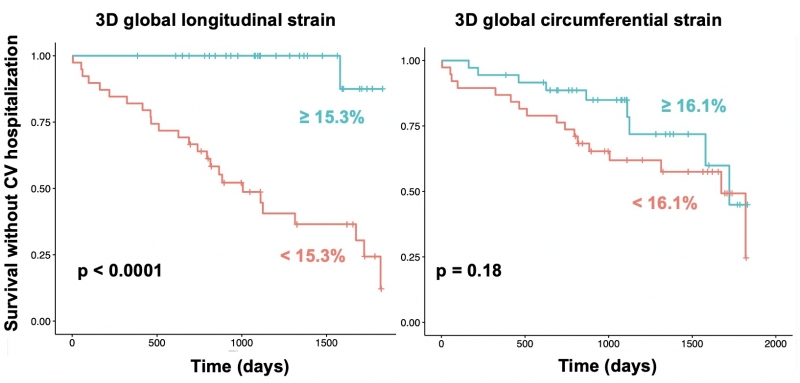ROLE OF MYOCARDIAL DEFORMATION ANALYZED BY 3D ECHOCARDIOGRAPHY IN FABRY DISEASE
Introduction: Fabry disease is a multisystemic lysosomal storage disorder caused by a defect in the gene coding the alpha-galactosidase A enzyme. Cardiac involvement typically manifests as a phenocopy of hypertrophic cardiomyopathy. Three-dimensional echocardiography can analyze myocardial deformation of the LV in both circumferential and longitudinal dimensions. Our goal was to assess the role of 3D deformation in relation to heart failure severity and long-term prognosis.
Methods: We analyzed data from 75 patients. 3D echocardiography was acquired using GE Vivid 9 and E95 machines. Death and all-cause cardiovascular hospitalizations over a median follow-up of 3.1 years were assessed.
Results: Average age was 47 ± 14 years and 44% of patients were male. Overall, 51% of patients had hypertrophy or concentric remodeling of the LV. Average EF was 65 ± 6% and two patients had EF < 50%. Average value of 3D GLS and GCS was 15 ± 5 % and 16 ± 4 %, respectively.
A stronger correlation was observed for NTproBNP with 3G GLS (r = 0.49, p < 0.0001) while correlation with 3D GCS was also significant, but weaker (r = 0.38, p < 0.001). Ejection fraction by 3D was weakly correlated with NTproBNP (r = 0.25, p = 0.036).
In the long-term follow-up, 3D GLS was significantly associated with long-term outcome (HR 0.79, CI 0.72 - 0.87, p < 0.0001, log rank p < 0.0001) while 3D GCS was borderline associated and only as a continuous variable (HR 0.87, CI 0.77 – 0.98, p = 0.0183, log rank p = 0.18). 3D EF was not associated with long-term outcome (p = 0.42 and 0.92).
Conclusion: 3D GLS was strongly associated with HF severity measured by natriuretic peptides and long-term prognosis. Only borderline association of 3D GCS and no association of EF with prognosis was observed. Longitudinal deformation analysis remains important for assessment of LV function in Fabry disease.
